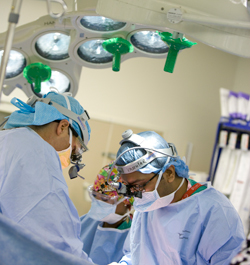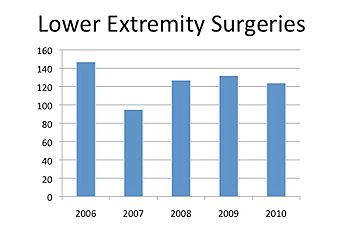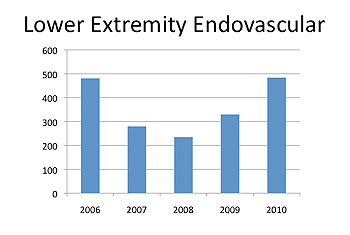Montefiore Einstein Center for Heart and Vascular Care – Vascular and Endovascular Surgery - Lower Extremity Ischemia - New York

Peripheral Arterial Disease, or PAD, generally refers to disease of the arteries outside the heart and brain. PAD is commonly seen as narrowing or blockages of arteries in the legs, although it can occur in the arms and arteries of the abdomen as well. Montefiore has long been recognized as a premiere limb salvage center regionally, nationally and internationally. Our vascular surgeons have extensive experience in dealing with vascular diseases of the upper and lower extremities and offer the full range of open, endovascular and hybrid approaches for the treatment of this disease.
Symptoms of Peripheral Arterial Disease
The majority of people with PAD will not have any symptoms and do not require any invasive treatment. Nonetheless, it is important to be aware that one has PAD in order to put in place lifestyle modifications to reduce the overall risk of a cardiovascular event. Such modifications include blood pressure control, dietary modifications, smoking cessation, and exercise. Other medical treatment can be beneficial as well. When symptoms do develop there is a wide range of possible symptoms. These range from pain in legs when walking (which may also be caused by other, non-vascular conditions), to constant pain in the legs, to ulcers and even gangrene.
Diagnosing the Disease
 PAD may be diagnosed by a number of methods, many of them non-invasive. The simplest test is an ankle-brachial index, or ABI. In this test the ratio of the blood pressures in the legs is compared to that in the arms. If the ratio is low, PAD is likely to be present. The next test is called a Pulse volume recording. In this test cuffs are placed on the legs, which allows the very small volume changes that occur with each pulse to be recorded. This test gives a measure of the overall blood flow at various levels within the lower extremities. If the waveforms are low, PAD is likely to be present. A duplex ultrasound mapping looks at the blood flow in the individual arteries in some detail. This test can detect narrowings or blockages without the use of needles, contrast dyes, or radiation. Other tests that diagnose PAD and locate blockages specifically include Angiography, CT angiography, and MR angiography.
PAD may be diagnosed by a number of methods, many of them non-invasive. The simplest test is an ankle-brachial index, or ABI. In this test the ratio of the blood pressures in the legs is compared to that in the arms. If the ratio is low, PAD is likely to be present. The next test is called a Pulse volume recording. In this test cuffs are placed on the legs, which allows the very small volume changes that occur with each pulse to be recorded. This test gives a measure of the overall blood flow at various levels within the lower extremities. If the waveforms are low, PAD is likely to be present. A duplex ultrasound mapping looks at the blood flow in the individual arteries in some detail. This test can detect narrowings or blockages without the use of needles, contrast dyes, or radiation. Other tests that diagnose PAD and locate blockages specifically include Angiography, CT angiography, and MR angiography.
Treatment Options
 Treatment for PAD can be performed using minimally invasive endovascular techniques, traditional open surgical techniques, or a combination of the two depending on the individual patient's anatomy and symptoms.
Treatment for PAD can be performed using minimally invasive endovascular techniques, traditional open surgical techniques, or a combination of the two depending on the individual patient's anatomy and symptoms.
Our vascular surgeons have particular expertise in the minimally invasive technique of subintimal angioplasty and helped pioneer this procedure in the United States. Other endovascular treatments offered include balloon angioplasty (with and without stenting), cryotherapy, and artherectomy (laser or mechanical). When endovascular options are not feasible, our surgeons remain international leaders in the performance of complex bypass surgery. These procedures can be performed with the patients own vein or synthetic grafts.
- Clinical Cardiology
- Diseases and Conditions
-
Services and Treatments
- Montefiore Advanced Lung Disease Program
- The James Scheuer, MD Division of Cardiology
- Diagnostic Tests for Heart and Vascular Disease
-
Treatments/Procedures for Heart and Vascular Disease
- Pacemaker
- Implantable Cardioverter Defibrillator
- Ablation
- Interventional Cardiology
-
Surgical Services
- Aortic Valve Surgery
- Aortic Valve Sparing Surgery
- Adult Congenital Heart Disease
- Aneurysm Surgery
- Heart Transplant
- Atrial Fibrillation Surgery
- Coronary Artery Bypass Surgery (CABG)
- Hybrid Revascularization
- Mechanical Heart Devices (LVADs)
- Minimally Invasive and Robotic Cardiothoracic Surgery
- Mitral Valve Repair and Replacement
- Pediatric Congenital Heart Surgery
- Robotic Heart Surgery
- Stem Cell Therapies
- Total Artificial Heart
- Transcatheter Aortic Valve Replacement (TAVR)
- Transmyocardial Revascularization (TMR)
- Vascular and Endovascular Surgery
- Ventricular Remodeling Surgery (SVR)
- Support Services for Heart and Vascular Disease
- Transcatheter Aortic Valve Replacement (TAVR)
- Cardiothoracic and Vascular Surgery
- Comprehensive Heart Valve Repair Program
- Tarrytown Cardiology Associates
- Bronx Medical Cardiac
- New Rochelle Cardiology
- Montefiore Einstein Pulmonary Hypertension Program
- Heart and Vascular Disease Prevention and Wellness
- Research and Clinical Trials
- About Us
- Education
- Contact
- Support the Heart and Vascular Center


